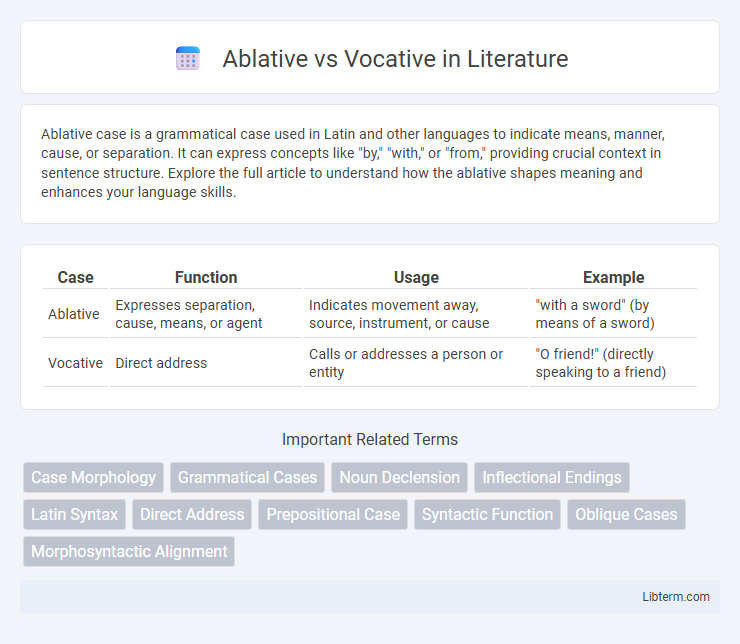Ablative case is a grammatical case used in Latin and other languages to indicate means, manner, cause, or separation. It can express concepts like "by," "with," or "from," providing crucial context in sentence structure. Explore the full article to understand how the ablative shapes meaning and enhances your language skills.
Table of Comparison
| Case | Function | Usage | Example |
|---|---|---|---|
| Ablative | Expresses separation, cause, means, or agent | Indicates movement away, source, instrument, or cause | "with a sword" (by means of a sword) |
| Vocative | Direct address | Calls or addresses a person or entity | "O friend!" (directly speaking to a friend) |
Introduction to Ablative and Vocative Cases
The ablative case primarily expresses means, cause, manner, or separation in Latin grammar, often indicating "by," "with," or "from." The vocative case serves to directly address or call upon someone or something, typically mirroring the nominative form except in specific declensions like the second singular masculine. Understanding the distinct syntactic roles of ablative and vocative cases is crucial for accurate Latin sentence construction and interpretation.
Defining the Ablative Case
The ablative case in Latin primarily indicates means, manner, cause, or separation, often translated as "by," "with," or "from." It expresses how or by what means an action is performed, including instruments, agents, and sources of motion or origin. Unlike the vocative, which directly addresses or calls upon someone, the ablative serves grammatical functions linked to adverbial relationships in a sentence.
Understanding the Vocative Case
The vocative case directly addresses or calls upon a person or entity, often marked by a distinct form in Latin and other inflected languages. Unlike the ablative case, which expresses means, manner, or separation, the vocative is used specifically for direct address, such as in names or titles, clarifying who is being spoken to. Understanding the vocative case enhances clarity in communication by distinguishing the addressee from other grammatical roles in a sentence.
Key Differences Between Ablative and Vocative
The ablative case in Latin primarily indicates separation, means, or cause, often translated as "by," "with," or "from," while the vocative case is specifically used for direct address, calling or invoking someone or something. Ablative forms commonly answer questions like "with what?" or "from where?" whereas vocative forms directly name the person or thing being spoken to, often identical to the nominative except in singular second declension nouns ending in -us, which change to -e. Understanding the syntactic role clarifies that the ablative functions within sentence structure to show relationships, whereas the vocative stands apart to engage the listener or reader directly.
Functions of the Ablative Case in Language
The Ablative case in Latin serves multiple functions including indicating means or instrument, expressing accompaniment with prepositions like "cum," and denoting separation or source. It also marks cause, manner, and agent in passive constructions, providing essential grammatical and semantic roles within sentences. Unlike the Vocative, which addresses or calls upon a noun directly, the Ablative modifies the relationship between the noun and the action or state described.
Uses of the Vocative Case in Communication
The vocative case primarily serves to address or call upon someone directly, signaling attention in dialogue or discourse. It is often used in greetings, commands, or when invoking someone's name to establish clear communication and engagement. Unlike the ablative case, which expresses separation or means, the vocative strictly functions as a grammatical tool for direct interaction between speakers.
Common Examples of Ablative Usage
Common examples of ablative usage in Latin include expressing means or instrument, such as "gladio" meaning "with a sword," and indicating accompaniment, as in "cum amico" meaning "with a friend." The ablative case also frequently denotes separation or origin, for example "ex urbe" translating to "from the city," and cause or reason, like "timore" meaning "because of fear." This contrasts with the vocative case, primarily used for direct address, such as "Marce!" meaning "O Marcus!" which does not express these relationships.
Typical Scenarios for the Vocative Case
The vocative case is typically used in direct address, calling out to a person or entity to capture attention or express emotion. Common scenarios include addressing a friend by name ("Marcus, come here!"), invoking deities in prayers or rituals ("O Jupiter, grant us victory!"), and commanding or requesting directly ("Teacher, may I ask a question?"). This case highlights the person spoken to, distinguishing it from other cases like the ablative, which primarily indicates means, manner, or cause.
Mistakes Learners Make with Ablative and Vocative
Learners often confuse the ablative and vocative cases due to their similar endings in Latin, leading to grammatical errors such as using the ablative form for direct address instead of the vocative. Mistakes commonly include misidentifying the vocative singular of second declension nouns ending in -us, where the correct form is -e (e.g., "Marcus" becomes "Marce" in vocative, not ablative "Marco"). Confusing ablative case functions like means or separation with vocative's role in direct address disrupts sentence clarity and accuracy.
Conclusion: When to Use Ablative vs Vocative
Use the ablative case to express means, manner, cause, or separation in Latin, often accompanied by prepositions like "cum" or "ex." The vocative case specifically addresses or calls out a person or entity, standing apart from the subject and serving a direct communicative function. Choose ablative for expressing relationships or circumstances, and vocative when directly addressing or invoking someone.
Ablative Infographic

 libterm.com
libterm.com